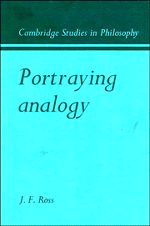Book contents
- Frontmatter
- Contents
- Dedication
- Preface
- Introduction
- 1 The limitations of classical analogy theory and the Miller's Analogies transition
- 2 The genus: meaning differentiation
- 3 Predicate schemes: an explanatory model
- 4 Equivocation, analogy and metaphor
- 5 Denominative analogy and paronymy
- 6 Figurative discourse
- 7 Analogy and religious discourse: craftbound discourse
- 8 Analogy and analysis
- Notes
- Bibliography
- Name index
- Subject index
- Frontmatter
- Contents
- Dedication
- Preface
- Introduction
- 1 The limitations of classical analogy theory and the Miller's Analogies transition
- 2 The genus: meaning differentiation
- 3 Predicate schemes: an explanatory model
- 4 Equivocation, analogy and metaphor
- 5 Denominative analogy and paronymy
- 6 Figurative discourse
- 7 Analogy and religious discourse: craftbound discourse
- 8 Analogy and analysis
- Notes
- Bibliography
- Name index
- Subject index
Summary
The same word often has different but related meanings (e.g. catch/fish; catch/ball). Some philosophers have proposed that shades and kinds of such differences can be explained systematically. Aristotle and Aquinas developed theories of analogy to account for such phenomena, theories they applied to the philosophy of language, metaphysics, philosophy of science, philosophy of nature, theology and ethics, and that distinctively characterized their philosophical styles and even their products, such as analogous definitions.
After investigating the analogy doctrines historically, (Ross 1958, 1961, 1962a and b) and applying them to religious discourse (1970b), I began to examine whether the ‘classical account’, the account developed from Plato and Aristotle through Aquinas and Cajetan (1498), approximates the truth or points toward truths about meaning with similarly comprehensive consequences for contemporary philosophy.
By 1970 it emerged that the analogy phenomena have to be comprehensively redescribed because the classical theory suffers from limitations of scope and perspective (see chapter 1) and is based upon false premises, chiefly: (1) that word meanings are ideas (concepts-, thoughts-) in-the-mind-signified-by-conventional-sounds; (2) that sentence meaning is the molecular sum (syncategorematically computed) of the atomic meanings of the component words; (3) that different meanings for the same word are formally caused by differences in the referents, differences that are reflected in the conceptions, formed by abstraction, that are the meanings of the words; and (4) that only some words are analogical, equivocal, and the like.
- Type
- Chapter
- Information
- Portraying Analogy , pp. ix - xiiPublisher: Cambridge University PressPrint publication year: 1982



